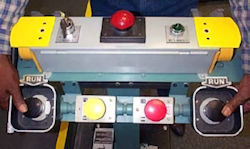Two-Hand Trip Devices
Two-hand trip devices require the operator to press two separate control buttons at the same time to start the machine cycle. Once activated, the operator's hands are free, which makes it different from two-hand controls that require continuous hand pressure.
This device is commonly used with machines that have full-revolution clutches, such as mechanical power presses. These machines complete a full cycle once started and cannot be stopped mid-cycle. That makes it especially important to prevent access to the danger zone while the machine is running.
To ensure safety, the control buttons must be located at a distance that prevents the operator from reaching into the point of operation before the machine finishes the first half of its cycle. This distance is calculated using the cycle speed and a standard value known as the hand speed constant.
Key Safety Features and Guidelines
The key features of a two-hand trip device include the following:
- Simultaneous activation: The operator must press both buttons at the same time. This ensures both hands are away from the danger area when the machine begins to operate.
- Safe distance: The control buttons must be placed far enough from the machine's point of operation. This prevents the operator from reaching the danger zone in time to be injured.
- Anti-cheating design: Controls should be arranged so that the machine cannot be activated with elbows, hips, or other body parts. Only hand operation should be possible.
- Full-cycle operation: After activation, the machine completes a full cycle. It cannot be restarted until both buttons are pressed again, reducing the risk of unintended repeats.
Example
An operator working on a mechanical press must press two buttons—one with each hand—located on opposite sides of the control panel. These buttons are spaced far apart to make sure the operator uses both hands. When both buttons are pressed, the machine starts its cycle. Since the operator’s hands were on the controls, they are safely away from the moving parts during operation.
| Safeguarding Action | Advantages | Limitations |
|
Concurrent use of two hands on separate controls prevents hands from being in the danger area when machine cycle starts |
Operator's hands are away from danger area Can be adapted to multiple operations No obstruction to hand feeding Does not require adjustment for each operation |
Operator may try to reach into danger area after tripping machine Some trips can be rendered unsafe by holding with arm or blocking, thereby permitting one-hand operation Protects only the operator May require special fixtures |
Knowledge Check Choose the best answer for the question.
3-8. Which device requires the placement of hands on both control buttons at the same time to activate the machine cycle, after which the hands are free?
You forgot to answer the question!

